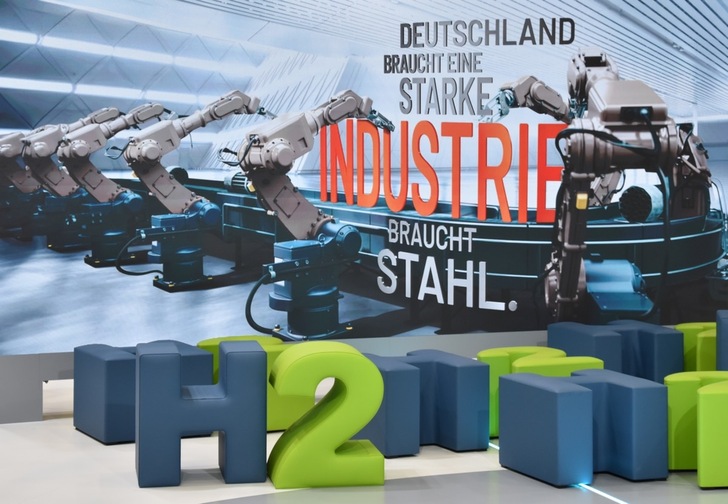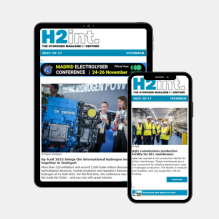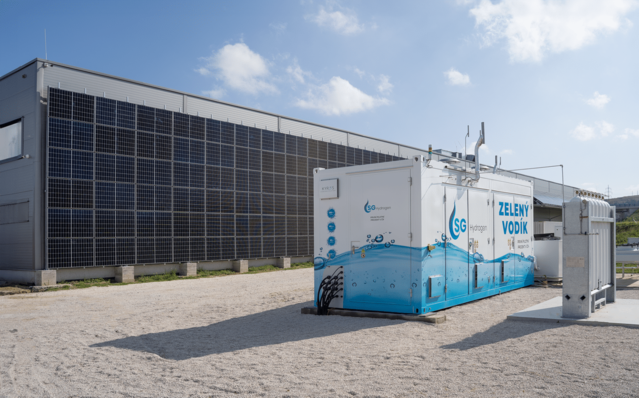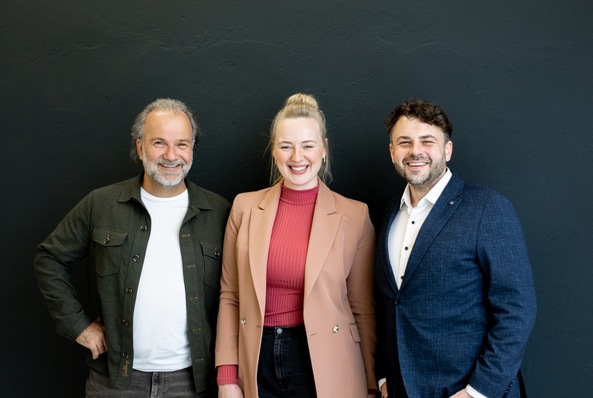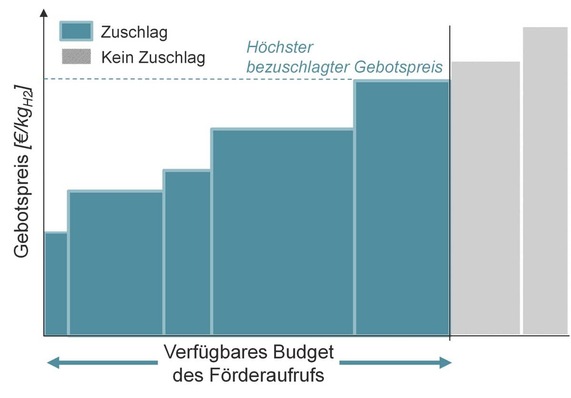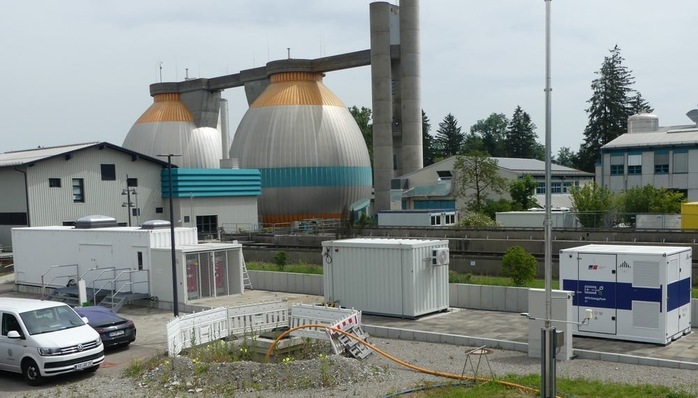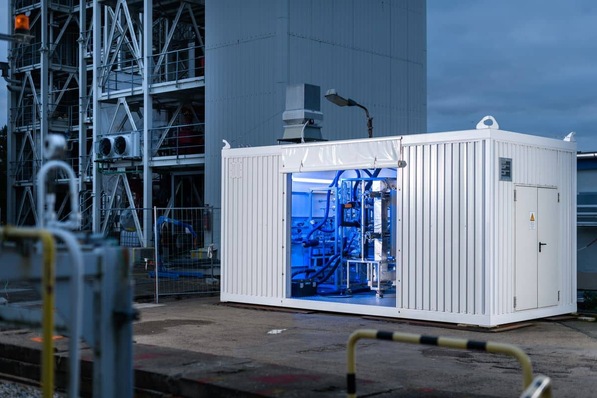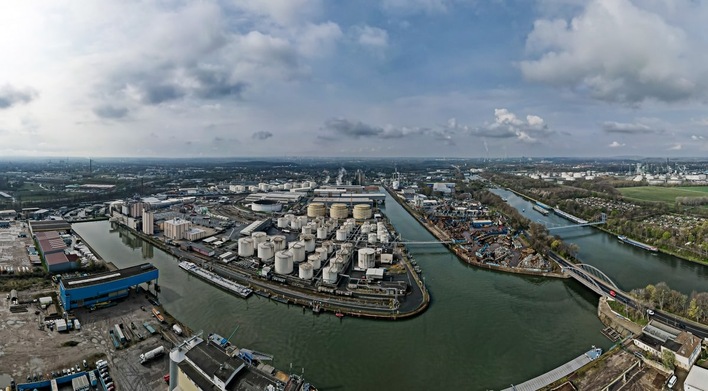Hannover Messe still lays claim to being the world’s most important industrial trade fair – according to Dr. Jochen Köckler, the board chairman of Deutsche Messe AG, it is even the “mother of all trade fairs.” As in previous years, it also benefited from April 22 to 26, 2024 immensely from the current H2 boom. The great interest in hydrogen and fuel cell technology once again led to acceptable exhibitor and visitor numbers. New impetus as an indication of the direction in which the traditional trade fair business could develop there were however none.
It could be said that the H2 fair has once again rescued Deutsche Messe’s balance sheet.
Chancellor Scholz visits H2 businesses
Not without reason did German chancellor Olaf Scholz give Hydrogen + Fuel Cells Europe a visit. The focus of his opening tour lay in the energy halls, where he stopped at Salzgitter (“We’re proceeding together on the trip” – see Fig. 2) as well as by GP Joule. Ove Petersen, cofounder and one of the managing directors of GP Joule, stressed how important the improvement of political framework conditions are to actually be able to establish electrolyzer capacities (see also p. 18).
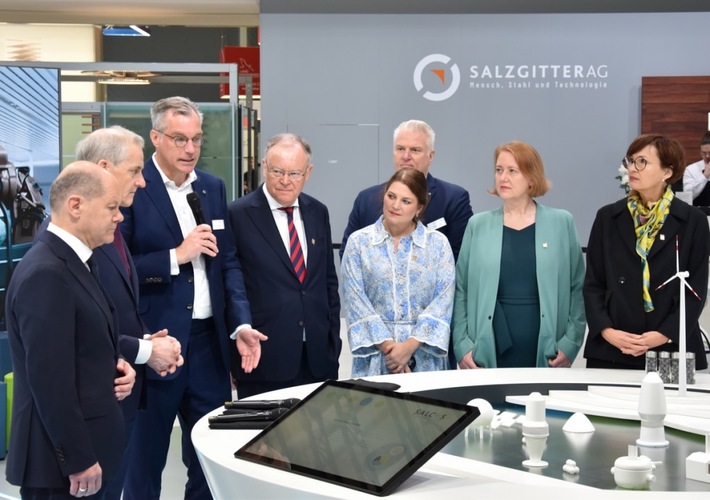
Chancellor O. Scholz with the Norwegian Minister-President J. G. Støre, Salzgitter head G. Groebler, Minister-President of Niedersachsen S. Weil, Norwegian economy minister C. Myrseth, German family minister L. Paus and German research minister B. Stark-Watzinger
Revealing word choice
Interesting to observe was how the word choice of some areas changed. For example, in numerous lectures were again and again talk of “Low-Carbon-Wasserstoff” (low-carbon hydrogen). With this crafted word, the speakers smoothly circumvent the classification of hydrogen into the, by some, really unpopular color scale. “Low-Carbon” implies that during the H2 production, little carbon dioxide is emitted, but avoids a stigmatization by the attribute “gray,” “blue” or “turquoise,” since even the smallest blending with green hydrogen is enough to be able to designate it as low-carbon.
Green or blue
For Olaf Lies, the state of Niedersachen’s economy minister, blue hydrogen is “a huge matter for achieving the climate targets.” In view of the tiresome discussion about color, he pointed out in Hannover that nobody asks about the color of electricity. “This must also be the case with hydrogen,” according to the minister.
Another innovation in the language style seems to concern the working principle in the hydrogen economy: Ever more frequently heard are sentences (in English), like “Partnership is the new leadership” or “Cooperation is key.” More and more players are realizing that the transformation process currently underway in the energy sector cannot be mastered alone, but only together.
What’s remained the same, in contrast, is the time horizon until the market ramp-up. Here we are still at five years. While in recent years it was still said that H2 trucks would be built in series starting 2025, representatives of the vehicle industry made it very clear that significant unit sales could not be expected in Germany until 2029 the earliest. Different is the situation in Asia: Refire advertised, for example, that it could already build 5,000 fuel cell systems per year.
After all, Dr. Matthias Jurytko, CEO of Cellcentric committed himself both to H2 technology and to Germany as a business location by saying: “Many talk about factories – We’re building one.” He also clarified: “Hydrogen will be the driver for long-haul transport.” At the same time, however, he conceded: “An increase in unit sales will not come until 2029/30.”
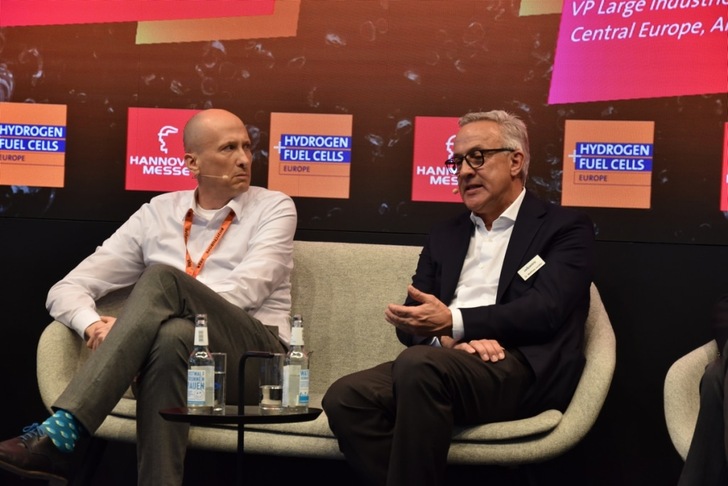
Dr. Jurytko: “There will be no long-haul transport without hydrogen.”
At around the same time, gray hydrogen could be just as expensive as green hydrogen due to rising CO2 prices, anticipates Gilles Le Van from Air Liquide.
Lively exchange in the forums
In addition, in the Public Forum of Hydrogen + Fuel Cells Europe (see Fig. 3 and 4), exhibitors once again explained their new developments this year or discussed them with guests from industry and politics. For example, what framework conditions or incentives for sector coupling and flexibilization of energy consumption are still lacking, or where and how green hydrogen will be produced in sufficiently large quantities worldwide.
Also the question of how much hydrogen Germany will produce itself and how much will be imported from its European neighbors moderator Ulrich Walter discussed with various guests. Christian Maaß, head of the department for energy policy at the federal economy ministry (BMWK), cited estimates that Germany could produce just under half of its climate-neutral hydrogen requirements itself, with the remainder having to be imported.
When asked by the moderator why the electrolysis capacities would not be immediately increased to 20 GW by 2030, replied Maaß, “With higher targets I would be careful, as electrolyzers need a lot of electricity.” He therefore advocates aligning the production of green H2 with the expansion of renewable energy. Not least to avoid conflicting objectives, because the direct consumption of green electricity should have priority. In this respect, he assumes that large quantities of green hydrogen will probably be imported from overseas, in the form of ammonia, methane and SAF (sustainable aviation fuel). Overall, however, Germany will need around ten percent of the world’s H2 production, making it a global player.
A completely different view is held by Heinrich Gärtner, founder and CTO of the GP Joule Group. He was convinced “that we can produce much more green hydrogen domestically than we today think,” and explained: “We already have a large potential for renewable energies, and this is continuing to grow. This also increases the amount of surplus electricity that can be used to produce hydrogen using electrolysis.” This is not only sensible, but also necessary. This relieves the strain on the grids and enables local value creation. In his view, Germany only needs a tiny proportion of its land area to produce all the renewable energy it needs itself. “We have everything here: the technology and the infrastructure.”
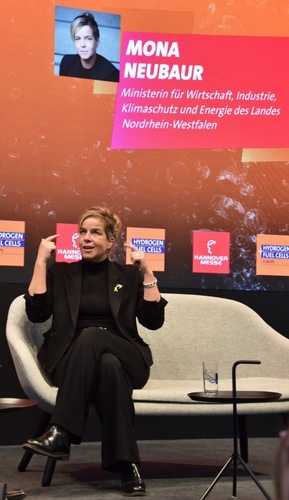
Numerous political representatives were on hand to answer questions
Cooperation in the European Area
Werner Diwald, chairman of the German hydrogen association (DWV), said, “The EU member states should be our main importing countries, not least to strengthen mutual relations and support stability within the European Union.” He also expressed optimism that the hydrogen economy could be ramped up quickly once a market and corresponding business models were in place. Something similar has already been seen with renewable energies. It should not be forgotten: The whole world needs green hydrogen. Germany therefore has a lot of competition, as other countries are also pursuing their own H2 strategies, according to Diwald.
The politicians present proved that the envisaged transformation process has long been underway with some impressive figures: For example, Olaf Lies spoke about 30 large gas-fired power plants in Niedersachsen that are to be made H2-ready. And his colleague Mona Neubaur, economy minister of Nordrhein-Westfalen (NRW), announced 200 hydrogen refueling stations by 2030. “We’re placing the infrastructure in the region with precision.” She asserted that NRW is to become the first CO2-neutral industrial region.
Hermes Startup Award: And the winner is …
As every year, the trade fair awards a prize to a particularly innovative company that is no more than five years old. For 2024, the Hermes Startup Award went to Archigas from Rüsselsheim, Germany. The company received the award for a moisture-resistant sensor for measuring hydrogen. The principle, which was developed together with the university Hochschule RheinMain, is based, according to the manufacturer, on an improved measurement of thermal conductivity on a microchip. The innovative technology is characterized by “miniaturization, robust design, short measuring times and a wide range of applications,” praised Prof. Holger Hanselka, president of the Fraunhofer research institutes and chair of the jury for the Hermes Startup Awards. Archigas is an “excellent example for innovation-driven businesses,” which have created the basis for the hydrogen economy to form.
Norway as a pioneer for green industrial transformation
The partner country Norway was represented with its own pavilion on the topics of energy, process industry, battery and charging solutions, and digitalization in Hall 12 and also on the orange carpet of the H2 trade fair – with the (English) slogan “Pioneering the Green Industrial Transition.” As an energy producer and pioneer in e-mobility, the Scandinavian country sees itself as a kind of catalyst for accelerating the green transition to a low-carbon society. For example, in the development of renewable energies and the use of digital solutions to trim the industry to net zero, as the H2 expert and former LBST employee Ulrich Bünger explained, who in “retirement” advises Norwegian Energy Partners (Norwep). The aim is to produce around four percent of Europe's estimated ten million tonnes of hydrogen imports by 2030.
“Norway and Germany are important trading partners, and we have entered into a strategic industrial partnership for renewable energy and green industry,” said the Norwegian trade and industry minister Jan Christian Vestre in the opening of the fair. “We hope that the Norwegian presence at Hannover Messe will further strengthen this close cooperation between our two countries,” he said.
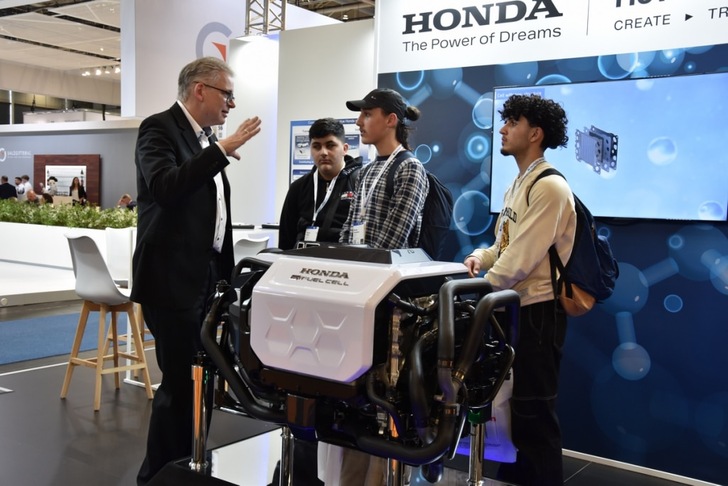
Honda showed its new FC system
The EEA (European Economic Area) Agreement means that Norway is fully integrated into the European single market, so trade and investment should flow seamlessly between Norway, Germany and the other countries of the European Union. During the trade fair, Germany also concluded an agreement with its Scandinavian partner on the storage of carbon dioxide (carbon capture and storage, CCS).
A major order was able to be announced by Norwegian manufacturer of hydrogen storage systems Hexagon Purus. Starting the second quarter of 2024, it will supply H2 tanks to the Berlin-based company Home Power Solutions (HPS), which claims to have developed the world’s first year-round electricity storage system for buildings. The Picea system will be primarily used in single-family homes in combination with PV modules. Surplus solar power, which is mainly generated in summer, will be converted into green hydrogen using an electrolyzer, which will be stored in high-pressure tanks from Hexagon. In winter, this is then used for reconversion to electricity. According to information from HPS, this allows buildings to be supplied with solar energy all year round. “Our high-pressure hydrogen tanks are flexible and scalable, making them suitable for a wide range of applications,” such as with HPS, said Matthias Kötter, managing director of the location in Weeze.
Creativity and inventiveness in Hall 13
A product innovation was presented for example by SFC Energy with the EFOY H2PowerPack X50, a pilot series for the most powerful fuel cell system to date with up to 200 kW in cluster operation. According to the FC specialist from Bavaria, this latest development offers the user a continuous electrical output power of 50 kW. However, up to four of these H2PowerPacks can be connected together to reach an output of 200 kW. The environmentally and climate-friendly alternative to diesel generators is equipped with standard 400 V AC connections, an integrated lithium battery and a 300‑bar hydrogen interface.
The operation is, according to information from the manufacturer, emissions-free; no CO2, carbon monoxide, nitrogen oxides or fine particles are emitted. Likely applications include the emergency power supply of hospitals or communication and IT systems, mobile power supply for construction sites and events or a continuous power supply for self-sufficient companies. “With the push into higher performance classes, SFC Energy is responding to correspondingly high market demand,” announced the company founded in 2000 and headquartered in Brunnthal near Munich. The series production and market introduction are planned for the beginning of 2025.
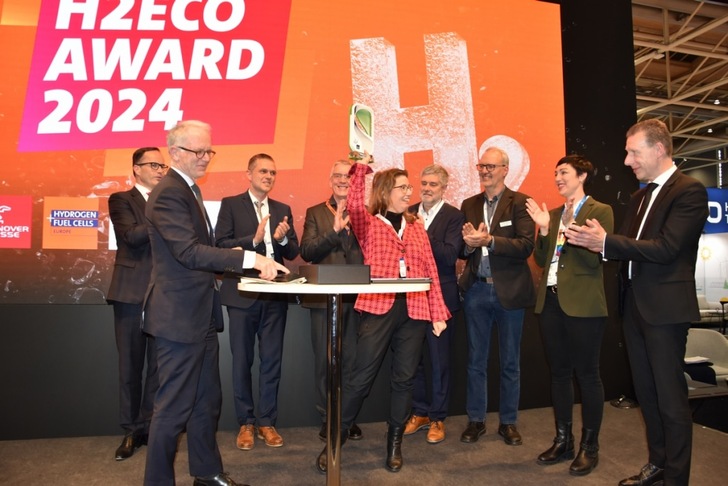
This year's H2 Eco Award went to the energy park Bad Lauchstädt
Lhyfe expands
What the hydrogen ramp-up looks like from the perspective of the Lhyfe Group, which now operates in eleven European countries, was reported by Luc Graré, who heads the Central and Eastern Europe division: “We are right now scaling up our production.” He describes the philosophy of the hydrogen pioneer, which was founded in 2017, as follows: “We start small, learn, grow, learn again, grow further and then scale up.” After the company started with an electrolysis capacity of one megawatt in France, it is now 10 MW.
Currently, six production plants for green hydrogen are planned or in the construction phase: Three in France, three in Germany. “And it will be increasingly more,” he said. A 10‑MW plant is currently under construction in the Niedersachen port town of Brake (on the Unterweser). Up to 1,150 tonnes of green H2 are to be produced there annually, which will go to regional customers from the industrial and transport sectors. The company has secured the purchase of green electricity through long-term electricity contracts (PPAs) with operators of wind farms and photovoltaic systems.
Another 10‑MW plant has been under construction in Schwäbisch Gmünd in Baden-Württemberg since autumn 2023, and is scheduled to go into operation in the second half of this year – with a production of up to four tonnes of green hydrogen per day. Still under development is the plan to commission an 800‑MW plant in Lubmin, Mecklenburg-Vorpommern by 2029, which is to be built on the site of the decommissioned nuclear power plant. According to information from Lhyfe, the hydrogen produced there in the future could be fed into the emerging hydrogen network.
Formic acid as H2 storage
Even outside Hall 13 was a lot about hydrogen. At some stands it looked like a chemistry lab, with bubbling water in glass vessels or a cloudy nutrient liquid in transparent bioreactors. With one, Festo, in Hall 7 showed its latest achievement in H2 storage: the so-called BionicHydrogenBattery (see Fig. 7). It contains bacteria from Lake Kivu in Central Africa that convert hydrogen into formic acid in a natural process. In this chemically bound form, hydrogen is comparatively easy to store and transport. It is also more climate-friendly, as there is no need for energy-intensive compression or cooling to ‑253 °C to liquefy hydrogen. The conditions under which the microorganisms do their work are moderate: They need a temperature of 65 °C and a pressure of 1.5 bar.
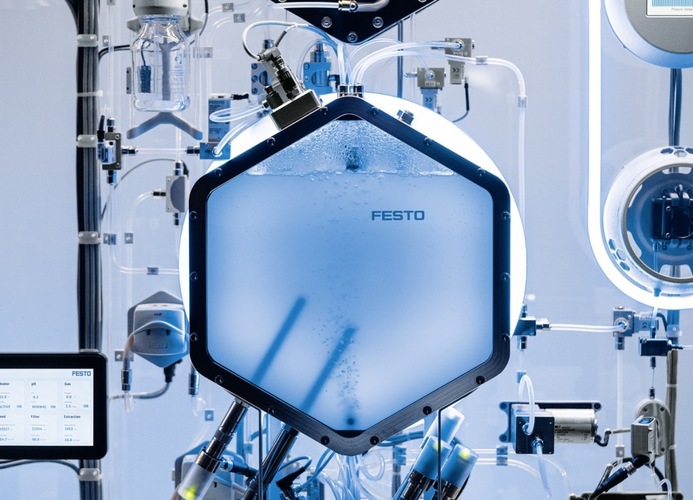
The cultivation reactor of the BionicHydrogenBattery from Festo
Normally, the bacteria called Thermoanaerobacter kivui live in sludge in the absence of oxygen (anaerobe). They have an enzyme with which they can convert hydrogen and carbon dioxide into formic acid (CH2O2). They can also reverse the process. The basic research in this area was carried out by the team around Volker Müller, Professor at the Goethe-Universität Frankfurt and head of the department of molecular microbiology and bioenergetics, with which the bionic project team of Festo, according to its information, is working closely.
From an economic point of view, the exciting thing about this biological process is not only the speed of the reaction, but also the fact that the bacteria act as catalysts: “They are not used up,” stated the globally active company specialized in automation technology and founded in Esslingen 1925. “The process can be repeated at will with sufficient regeneration phases – just like a cycle,” they stated. As the reaction can take place in both directions, bacteria of this type are able to break down formic acid back into hydrogen and carbon dioxide at the target site. The CO2 can then be used in the beverage industry, for example.
Positive conclusion
At the closing press conference, Jochen Köckler came to, as expected, a positive tally: More than 130,000 visitors from over 150 countries met 4,000 exhibitors from 60 countries. Of these, 40 percent of the visitors came from abroad: most of them from China and the neighboring Netherlands, followed by the USA, Korea and Japan. Gunnhild Brumm from the Norwegian business development organization Innovation Norway was pleased about the good business and contract conclusions: “In short: It was really worth it! It was a real boost for us. We would love to come back.” Not as a partner country again, of course, because next year that will be Canada.
“We are laying the foundations for the H2 economy of the future.... The speed of artificial intelligence (AI) is too high in some places, but we absolutely need more speed for hydrogen.”
Dr. Jochen Köckler, chairman of Deutsche Messe
Authors: Monika Rößiger & Sven Geitmann


